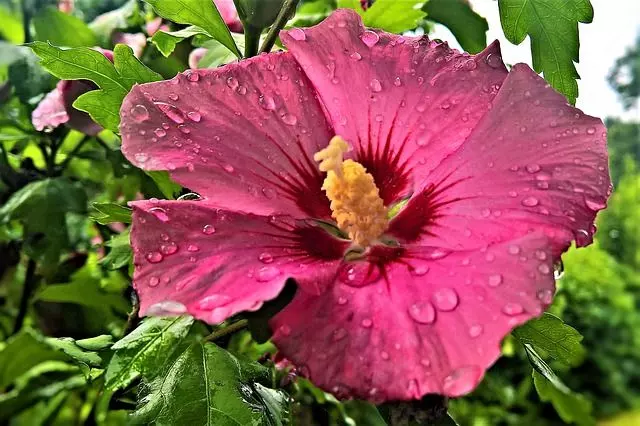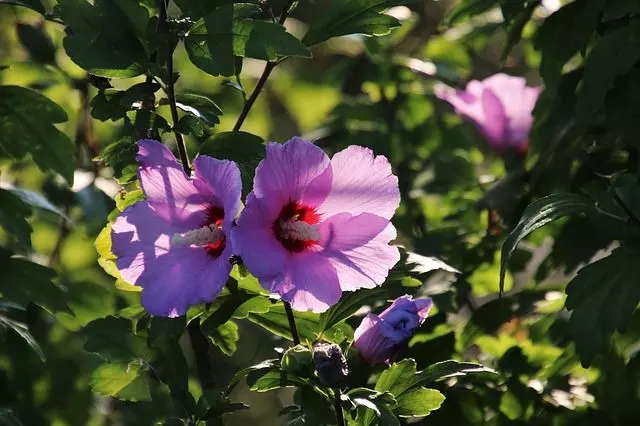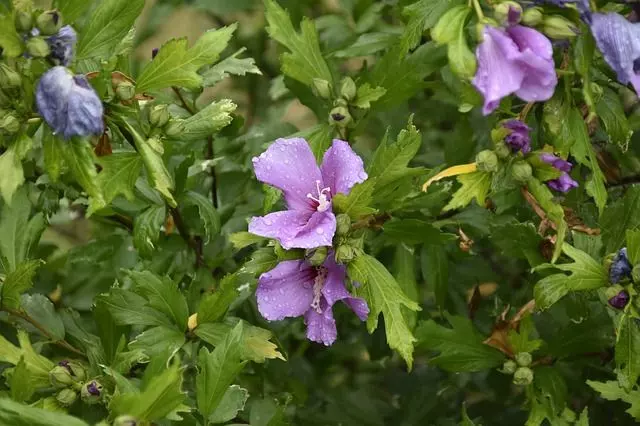Hibiscus syriacus is also known as Rose of Sharon is a beautiful shrub that blooms in the summer months. Despite its common name, this hedge is not a rose at all. No matter what name you call it, it’s just as lovely. This is our Rose of Sharon planting guide.
A favorite among many for its tropical appearance. Its large flowers vary between shades of pink, blue, red, white, and purple. They are usually wavy, giving the impression that they are made of crepe paper. They open in late summer to fall when others are still budding.
It is easy to grow, undemanding, and very happy in full sun or partial shade. Due to its nature, it prefers moist, well-drained soil, however, it is very tolerant of various growing conditions, including periods of drought as well as exposure to pollution. This aspect makes it excellent for urban gardens.
Try to do some research at your local garden center to find out what type of Hibiscus you are planting, as this may affect its flowering period. There are generally two types of Rose of Sharon Plant that is totally different in appearance.
Annual: does not tolerate cold temperatures. It has glossy deep green leaves, mostly yellow, pink, or red flowers, both single and double.
Perennial: dies back in the fall and returns the following spring. It is a shrub that flowers in red, pink, or white. With leaves of a very dull green color.
It is important for you to know that regardless of the type, its huge funnel-shaped flowers usually do not last more than a couple of days. However, this plant thrives abundantly.
Table of Contents
Rose of Sharon Planting Guide: When to Plant
Because it requires minimal maintenance, grows slowly, and has a natural resistance to pests, it is a favorite among hobbyists and dedicated gardeners. Planting is a fairly easy task that will only take a little time.
Rose of Sharon can be planted during the spring or fall. Generally, they tend to sprout a little late in the spring, so don’t be alarmed if you notice that your planting looks a little dull at the beginning of the season.
Once the planting process is complete, you can enjoy this new addition to your personal garden for a couple of years. To do the planting, try to do the following:
1- Determine the planting site. Make sure that it is not surrounded by other plants that prevent it from growing. The soil must drain very well.
2- Dig a hole. Dig a root system depth at least 2 to 3 times wider than the repot pot.
3- Repot the shrub. Gently place the container you bought it in in the ground. Carefully remove it and place it upright in the soil. Before filling the hole, add a quantity of water and let it soak in completely.
4- Refill the hole. Use the excavated dirt to backfill the hole. Press gently to stabilize it and water it again until the soil around it is soaked.
5- Apply compost or other fertilizer. Put it around the stem in an area large enough to cover disturbed dirt. Do not touch the stem directly.

Care Rose of Sharon Plant
Once the Hibiscus Syriacus is in the ground, you should know that its origins are key to the conditions of its development. In this sense, we share with you some of the general care that you should use in case you get it.
Water frequently, but do not add too much water. At least three times a week when it is young. As it matures reduce watering to twice a week.
Fertilize every spring, without overfeeding it. The proper feeding routine will keep it healthy and beautiful.
Prune in late winter or early spring to control its size.
Give it at least 6 hours of sun a day.

Pests or Diseases Hibiscus Syriacus
Yellow leaves that the Rose of Sharon plant gets over time usually means that these leaves are getting old and will soon be replaced. If you notice that your plant has too many yellow leaves, this means that it is stressed. The most common reasons are:
Lack of water
Pest infestation
Drastic environmental changes
Although few pests harm Hibiscus syriacus, in most areas where they are established; spider mites, aphids, whiteflies, and Japanese beetles are responsible for deteriorating their beautiful leaves.
There are many solutions to prevent or treat any infestation. Soap and water solutions, baking soda dissolved in water, commercial pesticides, or physical means can control any disease.

Rose of Sharon Planting Guide Tips and Recommendations
All varieties of Hibiscus syriacus typically bloom around August (northern hemisphere), with a blooming period of at least three weeks, which could be extended if the weather is warm. When grown in the right position it will take care of itself without demanding a lot of attention.
Take into account some of the best tips and recommendations that we share with you below so that you can take advantage of them every year:
1- How it likes full sun. In case you are in a very hot summer area and strong sunlight, provide shade during the hottest part of the day. If, on the other hand, there is no direct light, use supplementary lighting.
2- Take a distance of at least one meter between each hedge to allow ample growing space.
3- Before planting, if the roots are tight and twisted cut them a little to loosen the root ball.
4- Control watering. If it is waterlogged it will start to show yellow leaves because you are suffocating the roots.
5- If drainage becomes a problem, transplant it to an area that drains properly.
6- Use peat moss in the soil to increase drainage.
7- Avoid pruning during the summer.
8- Try planting in a straight line to create the effect of a colorful hedge or fence. You can even use it as a backdrop for smaller shrubs and flowers.
9- It will grow well in clay through light soils.
Learn more about when to prune hibiscus for winter.

